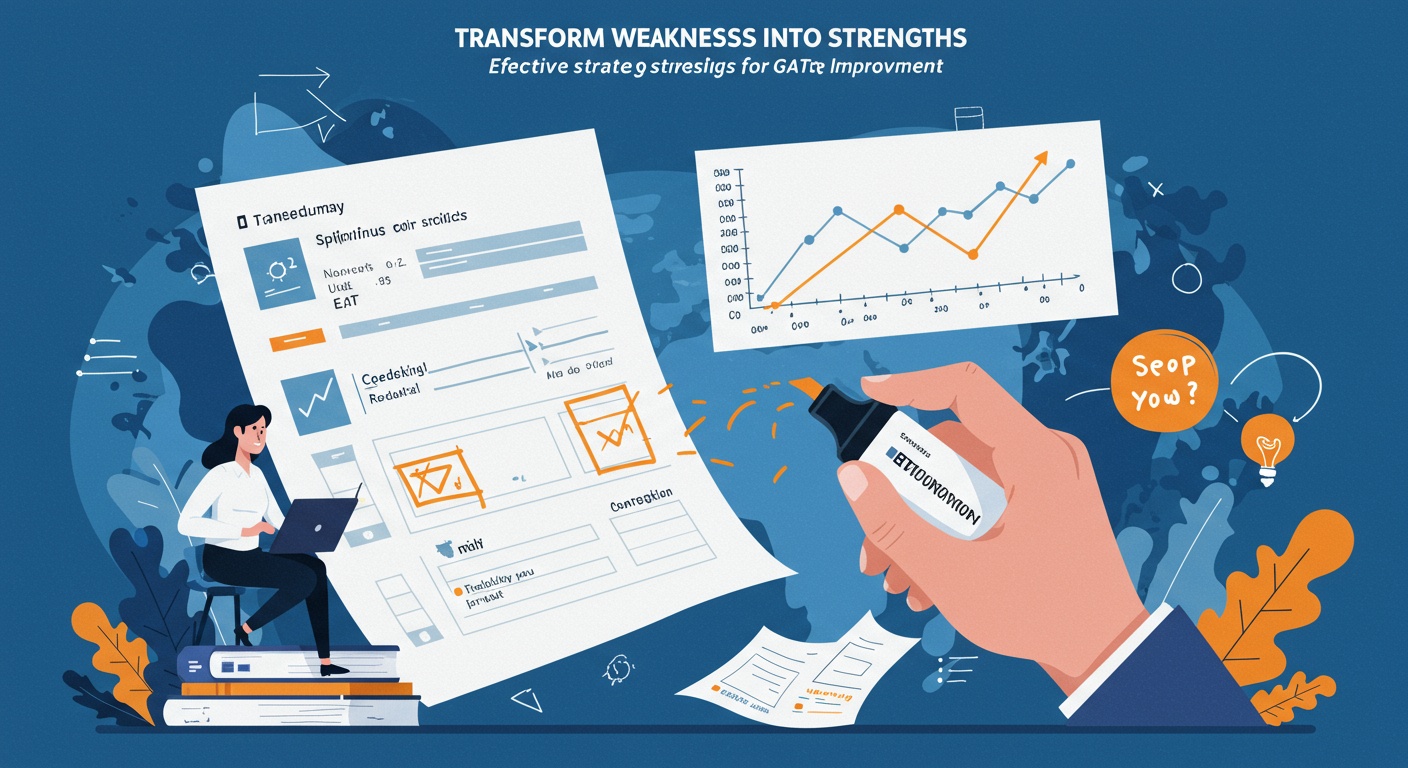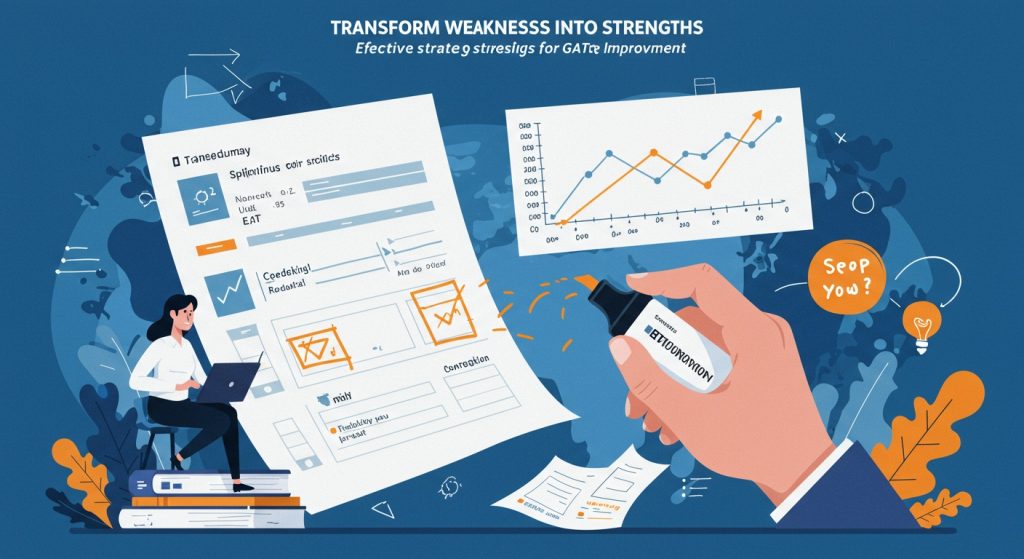For many aspiring engineers, the GATE examination presents an intellectual crucible, often highlighting specific subject areas like Complex Analysis or Data Structures as formidable challenges. Merely avoiding these perceived weaknesses proves detrimental, particularly as the GATE 2024/2025 pattern increasingly demands integrated conceptual understanding and application-based problem-solving across disciplines. Top scorers recognize that true mastery lies not in avoiding difficult topics. In methodically dissecting and strengthening them. Transforming these problematic areas from vulnerabilities into core competencies is the definitive pathway to unlocking peak performance and achieving a competitive edge in one of India’s most rigorous technical examinations.

Understanding Your Weaknesses: The Crucial First Step
Embarking on the journey to ace the GATE (Graduate Aptitude Test in Engineering) exam is a formidable task. A common challenge many aspirants face is grappling with their weak areas. The path to transforming these weaknesses into strengths begins not with aggressive study. With honest self-assessment. Before you can truly comprehend How to improve weak areas for GATE Exam, you must first identify them with precision.
- Comprehensive Self-Assessment: This isn’t just about recognizing a subject you dislike; it’s about pinpointing specific topics or types of questions within a subject where you consistently falter.
- Utilizing Mock Tests and Previous Year Papers: These are invaluable diagnostic tools. Approach them not just as practice. As diagnostic tests. After completing a paper, meticulously review every incorrect answer. Was it a conceptual error, a silly mistake, or a time management issue?
- Subject-Wise Analysis: Break down each subject into its core topics. For instance, in Electrical Engineering, if you struggle with Analog Electronics, delve deeper: Is it Op-Amps, Diodes, or BJT biasing? Identify the specific conceptual hurdle.
- Maintaining an Error Log: A simple yet powerful technique. Dedicate a notebook or a digital document to record every mistake you make in practice problems or mock tests. Categorize them by subject, topic. Type of error (conceptual, calculation, formula recall, interpretation). This log will visually highlight your recurring weaknesses.
As an example, consider a student, let’s call her Priya, who consistently scored low in Strength of Materials in her Mechanical Engineering GATE preparation. Initially, she just thought, “I’m bad at SOM.” But, after a detailed error analysis using her mock test results, she discovered her primary weakness wasn’t the entire subject. Specifically problems involving Mohr’s Circle and Torsion of Shafts. This precise identification allowed her to focus her efforts effectively.
Diagnosing the Root Cause: Why Are These Areas Weak?
Once you’ve identified your weak spots, the next critical step in understanding How to improve weak areas for GATE Exam is to interpret why they are weak. Without addressing the root cause, any remedial action might only offer temporary relief. Common reasons for persistent weaknesses include:
- Lack of Fundamental Understanding: Often, difficulties in advanced topics stem from a shaky grasp of basic principles. For instance, struggling with advanced circuit analysis might indicate a weak foundation in Kirchhoff’s laws or Ohm’s law.
- Insufficient Practice: Knowing a concept intellectually is different from being able to apply it under pressure. Many students comprehend concepts but haven’t solved enough varied problems to solidify that understanding.
- Conceptual Confusion or Misconceptions: Sometimes, a concept is misunderstood from the outset. This can lead to consistently wrong approaches to problems involving that concept.
- Silly Mistakes and Carelessness: These are not conceptual weaknesses but rather execution errors (e. G. , calculation errors, misreading questions, sign errors). While seemingly minor, they accumulate and significantly impact scores.
- Time Management Issues: You might know how to solve a problem but take too long, leading to an inability to complete the paper or rushing through other sections.
- Fear or Anxiety: A previous negative experience or perceived difficulty of a subject can create mental blocks, leading to avoidance or panic when encountering related problems.
Distinguishing between these causes is vital. For example, if your issue is a lack of fundamentals, simply solving more complex problems won’t help; you need to go back to basics. If it’s insufficient practice, then targeted problem-solving is the answer. A simple self-interrogation could look like this:
If I got this question wrong, was it because:
1. I didn't grasp the core concept at all? (Fundamental Gap)
2. I understood the concept but couldn't apply it to this specific problem type? (Application Gap/Insufficient Practice)
3. I made a calculation error or misread something? (Silly Mistake)
4. I ran out of time? (Time Management)
Strategic Approaches to Strengthen Weak Areas
With a clear diagnosis in hand, it’s time to implement targeted strategies. This section outlines actionable steps on How to improve weak areas for GATE Exam effectively.
1. Revisit Fundamentals and Build Strong Baselines
This is paramount. If your weakness stems from a shaky foundation, going back to the basics is non-negotiable. Don’t be afraid to pick up your 11th and 12th-grade textbooks or introductory engineering books. Many experts, including top educators in GATE preparation, emphasize that complex problems are often just sophisticated applications of basic principles. For instance, if you’re struggling with control systems, ensure your understanding of Laplace transforms and basic differential equations is solid.
- Utilize Standard Textbooks: Refer to widely accepted textbooks known for their clear explanations of fundamentals. For example, in computer science, “Operating System Concepts” by Silberschatz or “Data Structures and Algorithms” by Cormen, Leiserson, Rivest. Stein are excellent for foundational understanding.
- Online Resources: Platforms like NPTEL (National Programme on Technology Enhanced Learning) offer free video lectures from IIT professors, covering core engineering subjects comprehensively.
2. Targeted Practice and Problem Solving
Once concepts are clear, the focus shifts to application. This isn’t about random problem-solving but deliberate, focused practice on your identified weak areas.
- Break Down Complex Problems: Start with simpler problems related to the weak topic, gradually moving to more complex, multi-concept problems.
- Categorized Problem Sets: Seek out question banks that categorize problems by topic and difficulty. Solve all variations of problems within your weak topic.
- Focused Mock Tests: Instead of full-length mock tests, take topic-wise or subject-wise tests specifically on your weak areas to gauge immediate improvement.
3. Active Learning Techniques for Deeper Understanding
Passive learning (just reading or watching lectures) is often insufficient for cementing difficult concepts. Active learning forces engagement with the material.
- The Feynman Technique: This powerful method involves explaining a concept in simple terms as if you’re teaching it to someone else (or even a rubber duck!). If you can’t explain it simply, you don’t comprehend it well enough. Write it down, simplify it. Identify gaps in your own understanding.
- Concept Mapping: Visually organize details using diagrams, flowcharts. Mind maps. This helps in seeing the connections between different concepts and how they relate to the broader subject.
- Solving Diverse Problems: Don’t just stick to one type of problem. Try solving problems from different sources (previous year GATE papers, standard textbooks, coaching material) to expose yourself to various problem-solving approaches.
4. Strategic Time Management and Revision
Dedicated time allocation is crucial for addressing weaknesses.
- Allocate Dedicated Slots: Integrate your weak areas into your daily or weekly study schedule. Treat them as priority subjects. For example, dedicate 2-3 hours specifically to the weak topic every alternate day.
- Spaced Repetition: Revisit difficult concepts and problems at increasing intervals. This evidence-based learning technique helps in long-term retention. Tools like Anki can be used for this purpose.
- Regular Short Revisions: Instead of cramming, incorporate short, frequent revisions of weak topics.
5. Seeking Expert Guidance and Collaboration
Don’t hesitate to ask for help. Sometimes, an external perspective is all it takes to clarify a concept.
- Mentors and Teachers: Approach your professors, coaching instructors, or seniors who have cleared GATE. A one-on-one discussion can often clear doubts that online resources can’t.
- Study Groups: Collaborating with peers can be highly beneficial. Explaining concepts to each other, discussing problem-solving approaches. Even competing healthily can improve understanding and retention.
- Online Forums and Communities: Platforms like Stack Exchange, Quora, or dedicated GATE preparation forums can be excellent places to ask specific doubts and learn from others’ questions.
Implementing and Monitoring Progress
Identifying and strategizing are only half the battle; consistent implementation and diligent monitoring are what truly determine your success in understanding How to improve weak areas for GATE Exam.
1. Create a Detailed, Flexible Study Plan
Your plan should explicitly integrate the strategies for your weak areas. Don’t just list subjects; list specific topics and the approach you’ll take (e. G. , “Monday: 9-11 AM – Digital Logic – K-Maps & Boolean Algebra – Revisit NPTEL lectures, solve 20 problems from previous year GATE papers”).
- Be Realistic: Don’t overschedule. It’s better to stick to a modest plan than fail to adhere to an ambitious one.
- Flexibility: Life happens. If you miss a study session, don’t abandon the plan. Adjust it.
2. Regular Self-Assessment and Tracking
This goes beyond just taking mock tests. It’s about continuous feedback loops.
- Maintain a Progress Tracker: This could be a simple spreadsheet or a notebook. For each weak topic, track:
- Date of study
- Concepts covered
- Number of problems solved
- Accuracy rate in those problems
- Any lingering doubts or specific sub-topics that still pose a challenge
- Mini-Tests: After completing a round of focused study on a weak topic, take a short, timed quiz composed solely of questions from that topic. This provides immediate feedback.
3. The Role of Mock Tests in Monitoring Improvement
Full-length mock tests are crucial benchmarks. After dedicated effort on your weak areas, take a full mock test to see if your efforts are translating into better scores. When analyzing these mock tests, pay close attention to the performance in your previously weak areas. Are the number of incorrect answers decreasing? Is your speed improving? Are you committing fewer silly mistakes?
A comparison table can illustrate how your approach to weak areas should evolve:
| Phase | Approach to Weakness | Key Activity | Monitoring Metric |
|---|---|---|---|
| Identification | General awareness of subject difficulty | Full-length mock tests, error log creation | Overall score, number of incorrect answers per subject |
| Diagnosis | Pinpointing specific conceptual/application gaps | Detailed error analysis, self-interrogation | Categorization of errors (conceptual, silly, time) |
| Remediation | Targeted study, practice, active learning | Revisiting fundamentals, solving topic-wise problems, Feynman Technique | Accuracy in topic-wise quizzes, understanding clarity |
| Consolidation | Integrating improved areas with overall preparation | Timed practice, mixed problem sets, spaced repetition | Reduced errors in previously weak topics in mixed sets |
| Monitoring | Assessing overall progress and identifying new/residual weaknesses | Full-length mock tests, detailed performance reports | Improved scores in weak subjects, reduced overall error rate, time efficiency |
Mindset and Motivation: The Unsung Heroes of Improvement
Ultimately, your mental approach plays a colossal role in your ability to grasp How to improve weak areas for GATE Exam and actually implement these strategies. The journey of transforming weaknesses is often frustrating and challenging, requiring immense perseverance.
- Embrace the Challenge: View your weak areas not as insurmountable obstacles but as opportunities for significant score improvement. Every weakness overcome is a direct boost to your rank.
- Overcome the Fear of Failure: Many students avoid their weak areas due to a fear of getting things wrong. Interpret that mistakes are part of the learning process. Each incorrect answer is a step closer to understanding.
- Maintain Consistency and Perseverance: Improvement in weak areas is rarely linear. There will be days of frustration. The key is to keep showing up and putting in the work, even when motivation wanes. Consistency beats sporadic bursts of intense study.
- Celebrate Small Victories: Acknowledge and reward yourself for small achievements – understanding a difficult concept, solving a problem you previously struggled with, or seeing a slight improvement in a topic-wise test. This positive reinforcement is crucial for long-term motivation.
- Positive Self-Talk: Replace negative thoughts (“I’m so bad at this subject”) with constructive ones (“This subject is challenging. I’m making progress and learning new strategies”).
- Manage Stress and Well-being: Don’t neglect your physical and mental health. Adequate sleep, a balanced diet. Regular breaks or light exercise are essential for optimal cognitive function and sustained effort. Burnout will only exacerbate existing weaknesses.
As Prof. Barbara Oakley, co-creator of the popular “Learning How to Learn” course, often emphasizes, effective learning involves both focused and diffuse modes of thinking. When tackling a difficult concept, it’s beneficial to engage in focused study and then take a break, allowing your mind to process and connect insights in the background. This approach can be particularly helpful when struggling with complex GATE topics.
Conclusion
Weaknesses are not anchors. Rather compass points guiding your GATE preparation. True transformation begins when you stop avoiding challenging topics and instead, proactively dissect them. For instance, if, like many, you find ‘Strength of Materials’ numericals daunting, don’t just review theory; actively seek out previous year’s GATE questions from that topic, even if they seem advanced. My personal hack was to spend 30 minutes daily on just one challenging problem, dissecting it until the underlying concept clicked, rather than rushing through many. The evolving GATE pattern, leaning heavily into application-based questions over rote memorization, demands this proactive approach. Don’t just identify a weak area; schedule dedicated, focused practice sessions for it, perhaps leveraging current online platforms that offer topic-wise mock tests. Remember, consistency in confronting your academic fears builds resilience. Your GATE journey isn’t just about clearing an exam; it’s about forging the intellectual grit that will define your future engineering career. Believe in your capacity to convert every obstacle into a stepping stone. Success will undoubtedly follow.
More Articles
Pioneering Progress: Exploring Germany’s Leading Biotechnology Innovations and Career Paths
Build Your Biotech Career: Essential Skills and Education for Success in 2025
Navigate Your Future: Top Biotechnology Career Paths and Salary Insights
Unlocking the Future: A Beginner’s Guide to What Biotechnology Truly Is
FAQs
How can I really pinpoint my weak areas for the GATE exam?
Start by deeply analyzing your mock test results and previous year papers. Don’t just look at wrong answers; dig into why you got them wrong. Was it a conceptual gap, a calculation error, or time pressure? Also, reflect on topics you actively avoid during self-study – that’s often a tell-tale sign of a hidden weakness.
Once I know my weaknesses, what’s the best way to fix them?
It’s not just about re-reading. Break down complex weak topics into smaller, manageable chunks. Focus on understanding the core concepts first, then practice extensively with a variety of problems. If one resource isn’t clicking, try another – like video lectures, different textbooks, or even explaining the concept to someone else to solidify your understanding.
With so much to study, how do I find time to focus on weak spots without neglecting other areas?
Allocate dedicated ‘weakness improvement’ slots in your daily or weekly study plan. Even 1-2 hours consistently can make a huge difference. Prioritize the weaknesses that carry more weight in the exam or are fundamental to other topics. Don’t wait until the last minute; integrate this focused effort from the start.
Is it just about putting in more hours, or does my attitude play a role?
Absolutely, mindset is crucial! See weaknesses as opportunities for growth, not as failures. Be patient with yourself, celebrate small victories. Don’t get discouraged by initial slow progress. A positive, persistent attitude will fuel your efforts and make the entire improvement process much more effective.
Are there any specific study methods that are particularly effective for turning weaknesses into strengths?
Active recall (testing yourself without notes) and spaced repetition (revisiting topics at increasing intervals) are highly effective. For problem-solving weaknesses, try solving similar problems with slight variations, or even deriving formulas yourself. Don’t just watch solutions; try to solve them first, even if you fail, then review the solution thoroughly.
How do I know if I’m actually getting better in my weak areas?
Regularly re-test yourself on those specific topics using question banks or short quizzes. Compare your accuracy and speed with previous attempts. Keep a ‘weakness log’ where you track the topics, your initial score. Subsequent scores after dedicated practice. This visual progress can be very motivating.
Should I completely ignore my strong subjects to focus only on weaknesses?
No, that’s a common mistake! You need to maintain your strengths through regular revision and practice, perhaps dedicating less time but keeping them sharp. The goal is to elevate your weak areas to a decent level while ensuring your strong areas remain scoring opportunities. A balanced approach maximizes your overall score.



